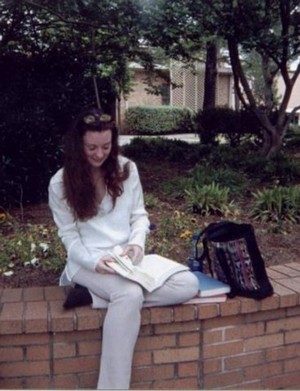When exploring the meaning of a text the inevitable result is that the reader will be incapable of separating the words written in the story or narrative from those that they may have read elsewhere regarding the life of the author of said story on a different occasion. In all cases an author’s work of art has been shaped by his/her own experiences or views; they can no more write an unbiased account of something, whether it is fictional or not, than the reader can enter into a new story with a clean slate. There is danger, however, in attempting to connect an author’s work too much with his personal life and history.
A piece of fictional literature is meant to express an idea or feeling that the author experienced and wanted to share in some way with a wider public. The reader’s task then is to read the work and derive his own feelings, satisfactory or not, from the text. If the reader is concentrating too much of his attention on what the author “might” have been implying or feeling while writing certain passages the reader loses his ability to extract a personal reaction or meaning from the work of art, undermining the work’s initial purpose.
Peter Coveney, in his article entitled “Escape”, explores the idea that Wonderland represents a nostalgic escape from reality, both for readers as well as Lewis Carroll himself; however, Coveney’s referral to Wonderland as being a “nostalgic prison” for Carroll distorts the original innocent idea of this escape and forever taints the childish and whimsical images that Wonderland evokes for its readers (Coveney 328). The reader, seeing Wonderland referred to as a prison is then led to imagine something dark and distorted when reflecting on Wonderland rather than the carefree escape they may have experienced previously. Wonderland, as a place, loses its ability to transport the reader back to a time of his own childhood by making this place undesirable to visit.
Carroll’s critics place much interest on his relationships with young girls throughout his life, as well as his preference for little girls over little boys, this preference probably lying in the Victorian notion of the sublime purity of children in general, but more specifically young girls. One critic points out that the Victorians “knew that the child, and especially the female child, was a sprite living an idyllic existence” (Cohen 8). Carroll’s role in these relationships has been referred to as everything from a father figure or dear friend to a pedophile. This harsh, unsupported accusation of pedophilia that has been attached to Carroll’s name forces critics to recognize the possibility of the validity of such an accusation when delving into his works. The accusation becomes interwoven with analysis done on the Alice books, as well as Carroll’s other works, regardless of the focus the critic has chosen. Coveney, for example, who is not specifically examining Carroll’s relationships with children, still refers to them when mentioning Carroll’s “frustrated exclusion from life” and the solace he finds in the young girls’ company (Coveney 330).
Despite this, though Coveney never makes any specific claims for or against Carroll’s private life he does cite several outsiders, at one point saying, “some with less interest in preserving a decent memory declare his [Carroll’s] face became girlish, and that he assumed the embarrassed mannerisms of a young girl” (Coveney 329). Coveney also goes on, as far as to mention the “dinner parties in college rooms for little girls” that Carroll was known to have held (Coveney 329). Without making any formal claims against Carroll’s private life himself, Coveney sets Carroll up as a disturbed man that in creating a fantasy world for his child friends actually created a prison for himself from which he may never return to reality. Coveney makes the statement, regarding not only Carroll but J.M. Barrie as well (an inclusion that furthered my anger at the article), that “the misery on the face of Carroll and Barrie was there because their response towards life had been subtly but irrevocably negated. Their photographs seem to look out at us from the nostalgic prisons they had created for themselves in the cult of Alice Liddell and Peter Pan” (Coveney 328).
Carroll’s own response to his two Alice books, however, presents a way in which he hopes the reader will approach the texts as well as how he hopes they will be fondly remembered. In the introductory poem to Alice’s Adventures in Wonderland, Carroll’s last stanza says:
Alice! A childish story take,
And, with a gentle hand,
Lay it where Childhood’s dreams are twined
In Memory’s mystic band.
Like pilgrim’s wither’d wreath of flowers
Pluck’d in a far-off land.
Carroll is expressing the wish that his readers or anyone that loves the Alice stories will look on them as a fond memory of their childhood when they are grown. He points out that a child’s dreams are twined with reality and that is where his stories should be placed.
Carroll, in the concluding poem of Through the Looking Glass, wrote “Life, what is it but a dream”, with which he seems to make reference to Edgar Allen Poe’s poem “All that we see or seem;/Is but a dream within a dream” (Carroll 209). These two quoted poems suggest that there is no clear cut division between dreams and reality, not only for children, but also for all people in general. If it is actually impossible to distinguish where the dream world ends and reality begins for any one person how can any one person make a claim regarding Carroll’s entrapment in his dream-world of Wonderland other than Carroll himself? Coveney does not have the ability to make the claim that Carroll’s dream world became his prison when Coveney can himself not distinguish how far Carroll had been submerged in Wonderland.
Many other critics have explored Carroll’s personal background and stemming from what they have found regarding it, made attempts at analysis of the text that involved some type of sexual outcome. This result seems somewhat odd considering that once the harsh accusation of pedophilia is discarded Carroll is regarded as not only virtually asexual, but also never once taking part in a sexual act with another human being. Yet, critics still have read sexual examples in the two books, such as the phallic imagery that one person claimed present when referring to “Alice’s ‘immense length of neck, which seemed to rise like a stalk out of a sea of green leaves which lay far below her'” (Goldschmidt 281). The general argument for the presence of these symbols in the two books is that they were an expression of or outlet for Carroll’s repressed and unrealized sexuality.
The case is not always that critics buy into the slander against Carroll’s private life, yet even if they do not it seems that it is still necessary for them to denounce such claims in their writings regarding the books. A critic, Bettina Hurlimann, writes, “but you have only to look at the face of Lewis Carroll, you have only to consult his diaries or the letters he wrote to his young friends to realize that there is nothing more to this story than an attempt to think up an amusing tale for a child of whom he was very fond” (Hurlimann 67). The accusations have become so entwined with Carroll’s “being” that those that support him feel obligated to denounce the slander and those that don’t support him are expected to reference it. Regardless of where the support lays the reference is still unfortunately made and the whimsy of the stories is therefore forever tainted for the readers.
Carroll, despite all of these accusations, which also occurred while he was alive due to his unaccustomed actions, was aware that people talked of him. He wrote to one of his sisters once regarding her worries about his reputation saying, “Anybody, who is spoke about at all, is sure to be spoken against by somebody: and any action, however innocent in itself, is liable, and not at all unlikely, to be blamed by somebody. If you limit your actions in life to things that nobody can possibly find fault with, you will not do much” (Cohen 9). He himself did not allow such things to affect his life on any great scale and persisted in doing what pleased him so long as it pleased his young friends. His Wonderland was not tainted by such accusations as so many others’ were.
Reference:
- Carroll, Lewis. Alice in Wonderland. edited by Donald J. Gray. Norton Critical Edition, ed. 2. New York, London: W.W. Norton & Company, 1992. Coats, Karen. Looking Glasses and Neverlands: Lacan, Desire, and Subjectivity in Children’s Literature. Iowa City: University of Iowa Press, 2004. Cohen, Morton N. “Lewis Carroll and Victorian Morality.”; Sexuality and Victorian Literature. edited by Don Richard Cox. Knoxville: University of Tennessee Press, 1984. pp. 3-19. Coveney, Peter. “Escape.”; Alice in Wonderland. edited by Donald J. Gray. Norton Critical edition, ed. 2. New York, London: W.W. Norton & Company, 1992. Goldschmidt, A.M.E. “’Alice in Wonderland’ Psychoanalyzed.”; The New Oxford Outlook. edited by Richard Crossman, Gilbery Highet, and Derek Kahn, 1933. Henkle, Roger B. “The Made Hatter’s World.”; The Virginia Quarterly Review. Winter, 1973. pp. 99-117. Hurlimann, Bettina. Three Centuries of Children’s Books in Europe. edited by Brian W. Alderson. Oxford: Oxford University Press, 1967. pp. 67-68. Irwin, Michael. “Alice.”; Rereading Victorian Fiction,: Reflections and Relativities. edited by Alice Jenkins and Juliet John. Houndsmills, England: Palgrave, 2000. pp. 115-128. Polhemus, Robert M. “Lewis Carroll and the Child in Victorian Fiction.”; The Columbia History of the British Novel. edited by John Richetti. New York: Columbia University Press, 1994. pp. 579-607. Sewell, Elizabeth. “’In the Midst of His Laughter and Glee’: Nonsense and Nothingness in Lewis Carroll.”; Soundings. 82, nos. 3-4 (fall-winter 1999): pp. 541-571.



